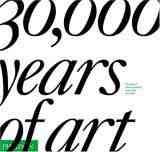Non-Fiction Reviews
30,000 Years of Art

- 30,000 Years of Art
- Phaidon Press, 1072 pp.
A Chronological Tour Through Art History
Ever since the day my copy of 30,000 Years of Art arrived, my postman has eyed me with a mild contempt. The size of this book, the weight of the thing! But let us ignore the strains of those in the employ of the Royal Mail and consider instead the merits of this publication.
‘Coffee table book’ is a familiar pejorative used to describe an intellectual lounge ornament which, should the need arise, can also serve as a doorstop, table prop or weapon in marital dispute. Who are these books produced for? Does anyone actually read them? Isn’t art meant to be seen in a gallery or on the walls of an artist’s home? Doesn’t art belong somewhere where you are able to approach it from a variety of angles? There surely needs to be harmony between space and art; art reduced to the flatness of the page rarely captivates. How can it? It has been stripped of its essence, pinned down like a dead butterfly in a display case. It is, after all, just a reproduction. All reproductions of art are like someone else’s holiday photos: they make you weary; they make you long to have the experience yourself. For what are you seeing? A copy of a moment that didn’t happen to you. However, if we cast my suspicisons aside for a time, does this book achieve what it sets out to do?
30,000 years of Art claims to be: ‘an unusual and exciting way of looking at art’; ‘a perfect introduction to those who are new to the subject.’ It consists of 1,000 masterpieces from ‘different countries, cultures and civilisations,’ and presents them ‘in simple chronological order.’ A short text accompanies each work which offers insight into its importance, its place in the history of art, and its cultural context. So what is so shatteringly new about this book? Well, it says that it is the only publication which aims to broaden our interest in art, moving it away from the traditionally narrow Western tradition: ‘Only here will you discover that while Diego Velázquez was painting the monumental royal family portrait Las Meninas, an unnamed artist in India was creating a jade wine cup for the Shah who built the Taj Mahal.’ While that is a quaint claim in the age of the internet, it is refreshing that this book affords so much room to sculptures, carvings, and cave paintings, that art is seen as something more than paintings by Western males.
There are lots of really good things about 30,000 Years of Art. The timeline is clear and accompanied by a chronology of significant historical events; the glossary allows you to search for a work by country, movement, artist, period and title. The texts are informative, readable, engaging, and do much to focus attention and create interest. They do succeed in giving a sense of the significance of each work, and certainly wetted the appetite of this reviewer. That is all such short texts can do: to make you want to find out more.
The big advantage of this book over the internet is that it is much easier to appreciate the works. There is, of course, no screen shimmer, and, as care has been taken with the images, you can get something from them – as much as it is possible to get anything from a two dimensional reproduction of a work of art. However, the disadvantages of the book are obvious and enormous. You wouldn’t want to cart this thing around with you unless you had a fairly sizeable cart to put it in. And, unlike the internet, the book is fixed.
Yes, it is certainly the case that I had never seen most of the pieces of work in this book before. And yet, while sitting with this book at my desk I couldn’t help but long to be standing up in a museum somewhere, moving around the art, seeing the dance of light about its surface, observing its slow transformation with my change of position, the alteration of perspective. However, if 30,000 Years of Art succeeds in turning only a handful of people on to art, then it will have achieved something. I just can’t help think that all of the copies thus far sold are gathering dust in forgotten corners.






1 Comment
You must be logged in to post a comment Login